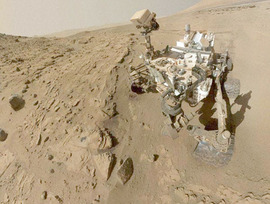
WASHINGTON - In a bid to understand how the once wet Red Planet turned cold and dry, NASA's Mars rover Curiosity has successfully drilled the first sample-collection hole in Mount Sharp, a layered mountain in Mars. The rover's hammering drill chewed about 2.6 inches deep into a basal-layer outcrop on Mount Sharp and collected a powdered-rock sample last week, NASA said in a statement.

Data and images received at NASA's Jet Propulsion Laboratory (JPL), Pasadena, California, confirmed success of the operation. "This first look at rocks we believe to underlie Mount Sharp is exciting because it will begin to form a picture of the environment at the time the mountain formed and what led to its growth," said Ashwin Vasavada, deputy project scientist at JPL. "This drilling target is at the lowest part of the base layer of the mountain and from here we plan to examine the higher, younger layers exposed in the nearby hills," Vasavada added. After landing on Mars in August 2012, Curiosity spent much of the mission's first year studying an area much closer to the landing site. "We are putting on the brakes to study this amazing mountain," Jennifer Trosper of JPL noted. "Curiosity flew hundreds of millions of miles to do this," Trosper maintained.
By investigating the chemical ingredients of the samples, the team hopes to gain information about the possible composition of fluids at this Martian location long ago.
By investigating the chemical ingredients of the samples, the team hopes to gain information about the possible composition of fluids at this Martian location long ago.

 RSS Feed
RSS Feed
